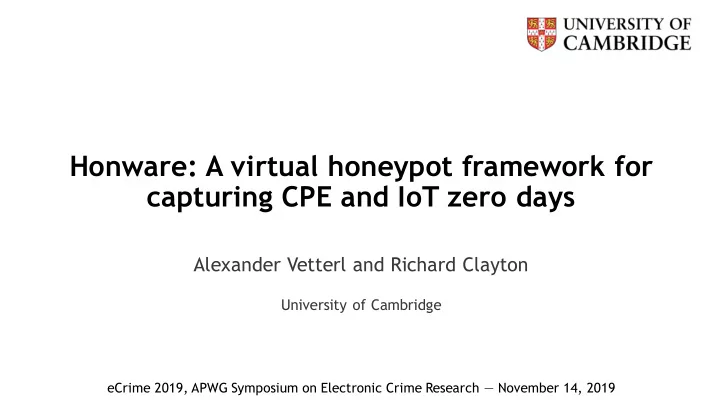

Honware: A virtual honeypot framework for capturing CPE and IoT zero days Alexander Vetterl and Richard Clayton University of Cambridge eCrime 2019, APWG Symposium on Electronic Crime Research — November 14, 2019
Introduction Honeypot: A resource whose value is being attacked or compromised — We are good in building software honeypots for specific Malware (e.g. Mirai) — Honeypots emulate a vulnerable device by sending appropriate strings back — Finding vulnerable devices never has been easier — Stateless scanning & Shodan, Censys, Thingful Problem: Slow, iterative process only suitable for well-understood attacks 2
Honware: Virtualised honeypot framework — Virtualised, because deploying and monitoring physical devices does not scale — Aimed for Linux-based CPE and IoT devices Appli- Appli- Appli- Telnet, SSH, Web, cation cation cation SSDP etc. — We need access to the firmware image and Firmware Filesystem the firmwares filesystem SIGNAL Networking HANDLING Custom Kernel — We want to run the firmwares ‘ applications NVRAM Logging such as Telnet, SSH and Web servers QEMU — Lightweight Host OS Kernel — <64MB RAM, <128MB disk space — Fast: Honeypots can be set-up in minutes! 3
SIGNAL Networking Customised pre-built kernel (1/2) HANDLING Custom Kernel Logging NVRAM We built kernels for ARM, MIPSEB and MIPSEL 1. Honeypot logging — do_execve 2. Signal interception — SIGABRT (abort) — SIGSEGV (seg fault) — SIGPFE (floating point errors) 3. Module loading — Ignoring vermagic strings (e.g. 2.6.22-xyz) 4
SIGNAL Networking Customised pre-built kernel (2/2) HANDLING Custom Kernel Logging NVRAM 4. NVRAM (non-volatile memory) — Set LD_PRELOAD to the path of our own nvram implementation — Intercept nvram_get and nvram_set calls 5. Network configuration — Look for bridge configuration: br0 and ra0 — If that fails, the kernel will execute a default configuration (customisable by users!) — Necessary interfaces — Assign static IP addresses 5
Step 1: Extracting firmware images Appli- Appli- Appli- cation cation cation Firmware Filesystem Binwalk — Looking for standard Linux filesystem structure (bin, usr, proc etc.) Creating an ext2 filesystem — Copying the firmwares ‘ structures and files — Typically very small (<128MB) Identifying the architecture based on ELF headers — e.g. Busybox binary — Used to select the appropriate kernel 6
Step 2: Modifying filesystem & preparation Supports custom configurations — Modified do_execve to execute, if present, /sbin/boot.sh through the kernel function call_usermodehelper Appli- Appli- Appli- Telnet, SSH, Web, cation cation cation SSDP etc. NVRAM emulation Firmware Filesystem SIGNAL Networking HANDLING — Added as kernel module Custom Kernel NVRAM Logging Network configuration QEMU — Re-route incoming packets on the host ethernet Host OS Kernel interface to the QEMU tap interface and — Post-route the packets back to the host 7
Evaluation — Extraction — 23,035 firmware images from Firmadyne (2016) — Network reachability — As of March 2019, 8,387 images can still be downloaded — Responding services — Firmadyne (2016) used 23,035 firmware images — Looked for self-identifying devices — As of March 2019, 8,387 images can still be — Timing attacks — Repeated measurements for three protocols: downloaded FTP , Telnet and HTTPS — Deployed multiple honeypots on the Internet — Case studies — Four case studies which show that devices can be rapidly emulated 8
Eval. 1: Extraction and network reachability
Evaluation 1: Responding services — Significantly more services respond on their listening ports — Telnet, HTTP , dhcp and UPnP are the most common services — Forcing network configuration is key (failed dhcp, missing nvram values etc.) 10
Evaluation 2: Timing attack — Attackers can use timing differences to detect honeypots — Using Shodan, we looked for three self- identifying devices (“banner”) — We set up a total of 30 honeypots, ten for each device, on two cloud providers — We measure the time the applications take to respond to our requests — RTT is calculated and is subsequently used to adjust the timing information 11
Evaluation 2: Timing attack (FTP and Telnet) ASUS RT-AC52U (FTP) Zyxel VMG1312-B10A (Telnet) Time between resource request Time to Login message (carriage return) and login message 12
Evaluation 2: Timing attack (HTTPS) D-Link DIR 825 (HTTPS) D-Link DIR 825 (HTTPS) Time between ClientHello and Time to complete the TLS resource received (web page) handshake 13
Evaluation 2: Timing attack conclusion — Emulation does not generally slow down applications — Low-cost cloud instances > CPE/IoT devices — Where emulation is faster, it would be possible to artificially slow responses — Internet inherently introduces jitter, network delays and artefacts — Increases time and effort to mount such attacks Attackers need to perform a significant amount of measurements to identify the discrepancies and fingerprint the honeypot 14
Case Study 1 - DNS hijacking attack Whilst emulating a router from ipTIME, we observed a DNS hijacking attack GET /cgi- bin/timepro.cgi?tmenu=netconf&smenu=wansetup&act=save& /sbin/iptables -t nat -A wan=wan1&ifname=eth1&sel=dynamic&wan_type=dynamic&al PREROUTING -i br0 -d low_private=on&dns_dynamic_chk=on&userid=&passwd=&mtu 192.168.0.1 -p udp --dport .pppoe.eth1=1454&lcp_flag=1&lcp_echo_interval=30&lcp_echo 53 -j DNAT --to-destination _failure=10&mtu.static.eth1=1500&fdns_dynamic1=185&fdns_ 185.117.74.100 dynamic2=117&fdns_dynamic3=74&fdns_dynamic4=100&sdns _dynamic1=185&sdns_dynamic2=117&sdns_dynamic3=74&sdn s_dynamic4=101 HTTP/1.1 >40 IPs with 118.30.28.10 the same AS41718: China Great Firewall certificate Network Limited Company 15
16
Case Study 2: ThinkPhP Malware — Emulating an ADSL modem router from TP-Link — Non-validated input allows attackers to run arbitrary code — >50k devices affected — We make malware available to the defender community considerably faster than traditional honeypots 17
Conclusion Framework to deploy honeypots for CPE/IoT devices — We use the real services/applications which are shipped with the device — Avoids misconfigurations, missing features/commands Better than existing emulation strategies in all areas — Extraction, network reachability, listening services Capable of detecting vulnerabilities at scale — Four cases which show that devices can be rapidly emulated — Rebalancing the economics of attackers by cutting the attackers’ ability to exploit vulnerabilities for considerable time 18
Q & A Alexander Vetterl alexander.vetterl@cl.cam.ac.uk 19
Recommend
More recommend